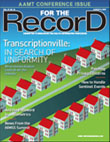August 6 , 2007
 Summer Vocation: HIT at the HIMSS Summit
Summer Vocation: HIT at the HIMSS Summit
By Neil Versel
For The Record
Vol. 19 No. 16 P. 8
There’s nothing like a little summertime reality check to keep everything in perspective.
About the only thing June’s HIMSS Summit had in common with its annual wintertime gathering is the sponsoring organization—that and a few tightly focused educational sessions.
Not present was the hype of some 900 vendor displays stretched across hundreds of thousands of square feet of a convention hall or the crush of 24,000-plus attendees. Long, grueling days with lots of meetings and sore feet were nowhere to be found. HIMSS outgrew the sprawling San Diego Convention Center following the 2006 annual conference; this time, the fewer than 300 people gathered for the HIMSS Summit fit comfortably into the meeting areas of an adjacent hotel.
And even in contrast to the 2005 summit, which drew more than 700 attendees to a prime New York City location to hear big-name keynoters such as Health and Human Services Secretary Michael Leavitt and former House Speaker Newt Gingrich, this year’s edition had a distinct, laid-back southern California vibe. But fluffy it was not.
Instead of sensory overload, summit attendees got up-close-and-personal with people who have enjoyed HIT success. Throughout the meeting, in-depth case studies were in vogue.
For example, to date, Geisinger Health System of Danville, Pa., has provided limited, read-only Web access to its central electronic medical record (EMR) for nearly 650 independent medical practices across its 41-county service area. Some may call that success. Geisinger President and CEO Glenn Steele, Jr, MD, PhD, calls it a good intermediate step.
Already, IT helps Geisinger provide primary and preventive care in rural areas and other locales with high incidence of chronic disease. “Health IT is an enabler for our strategy,” Steele said.
He also pointed out that the recent change to the Stark physician self-referral and Medicare antikickback rules to allow hospitals to purchase EMRs for practices they don’t own is going to increase access, allowing independent physicians to populate the EMR themselves, eventually giving Geisinger’s HMO the means to measure physician performance.
Among Geisinger’s own clinical staff, every work unit has to develop one or two quality initiatives each year, and electronic dashboards in the Epic Systems EMR help departments manage and measure their efforts. For acute episodic care, the health system has moved toward a global fee, similar to Medicare diagnosis-related groups, so there is an incentive to deliver quality. Local units are financially responsible for their “bogies,” Steele said.
Meanwhile, IT now makes up 4.2% of Geisinger’s annual budget—roughly twice the industry average. The technology helped the system turn around its financial fortunes in just 21/2 years, Steele said.
In another summit presentation, Kate Reynolds, RN, senior director of medical informatics at Evanston Northwestern Healthcare (ENH), explained how the three-hospital system in Chicago’s northern suburbs made workflow redesign the most important element of its $30 million, across-the-board EMR conversion.
“You can’t identify the participants until you identify the workflows,” Reynolds said. ENH identified 112 high-level workflows for its project and found processes that would not have been so obvious to IT planners had they followed departmental structures. ENH has departments within departments which have no line in the budget, such as the one-person wound care unit.
There were plenty of headaches along the way. “Physicians initially felt like they were losing autonomy [during the EMR rollout], so clinicians had to be a part of the governance,” Reynolds said. “Don’t forget the human functions [of workflow redesign].”
Furthermore, Reynolds recommended, workflows not only need to help practitioners, they also should be patient appropriate. That point often gets lost in IT planning, according to Reynolds.
Dealing with executive leadership is yet another minefield in IT strategy development, explained David Graser, senior vice president and chief information officer (CIO) of West Jefferson Medical Center in Marrero, La. “There’s nothing more jealously guarded than somebody else’s turf,” he said.
And, of course, the clinical staff presents its own set of challenges for senior management and IT personnel alike. “There’s nothing that will get us bit faster than telling people how to deliver clinical care,” the hospital’s head techie said.
To get around these potential hazards, Graser advised structuring the intraorganizational discussion in terms of sharing responsibility for achieving a common goal rather than “taking somebody’s candy.” He confers regularly with other “chief” officers and often attends medical staff meetings. “In general, they respect people who are really trying to help them,” Graser said of physicians.
Stephanie Mills, MD, chief medical information officer (CMIO) for another Louisiana organization, Franciscan Missionaries of Our Lady Health System in Baton Rouge, jokingly said that the term CIO has come to mean “career is over.”
In trying to disprove that theory, Mills, who was formerly the CMIO at the system’s flagship hospital, Our Lady of the Lake Regional Medical Center, recommended avoiding the term IT project in favor of framing the plan as part of an overall quality-improvement agenda. “It no longer was the IT strategy. It became a quality strategy,” Mills said.
HIMSS itself has been busy trying to engage physicians in IT initiatives. One week before the summit, the organization announced a partnership with the Association of Medical Directors of Information Systems to address issues related to physician informatics.
The partnership, called the HIMSS Physician Community, will have four general areas of interest: education and professional development of physicians involved in IT and management systems; public policy related to the delivery of safe and efficient care; improvement of the relationships between physicians and their patients, staff, and other healthcare constituencies; and standards and interoperability of health information.
“It’s a gathering, a community of physicians with a common interest in applied medical informatics,” explained Pat Wise, RN, HIMSS’ vice president of healthcare information systems.
— Neil Versel is a journalist in Chicago specializing in HIT.



